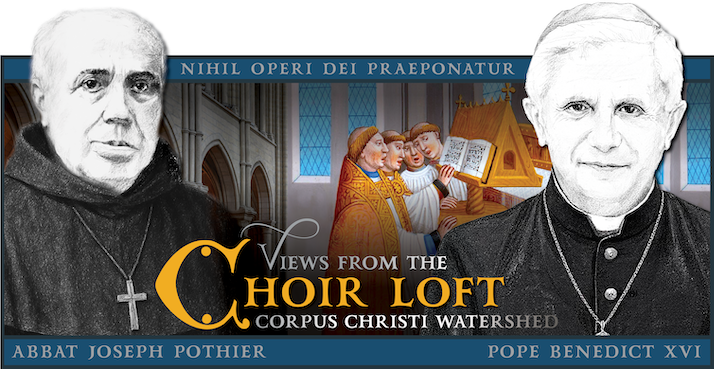 S OUR SCHOOL YEAR comes to an end, we slow down our academic endeavors but never fully stop enjoying the feast that is truth, goodness, and beauty. One of the delicacies that remains throughout the summer months is our hymn/chant study and this month we have chosen to learn “O Sacred Heart” and “Ave Verum Corpus.”
S OUR SCHOOL YEAR comes to an end, we slow down our academic endeavors but never fully stop enjoying the feast that is truth, goodness, and beauty. One of the delicacies that remains throughout the summer months is our hymn/chant study and this month we have chosen to learn “O Sacred Heart” and “Ave Verum Corpus.”
The month of June is dedicated to the Most Sacred Heart of Jesus, which is quite fitting for these times. This past week, the Church also celebrated the Feast of Corpus Christi. “The feast of Corpus Christi was proposed by St. Thomas Aquinas, Doctor of the Church, to Pope Urban IV in order to create a feast focused solely on the Holy Eucharist, emphasizing the joy of the Eucharist being the Body and Blood, Soul and Divinity of Jesus Christ.” 1

O Sacred Heart
The hymn, “O Sacred Heart,” was written by Francis Stanfield (1835-1914), an English Catholic priest, who worked in Westminster. He is known for writing many hymns. He was the son a landscape artist and was friends with Charles Dickens (a fun fact my daughter enjoyed!). The hymn is set to a tune by Sir Richard R. Terry, a musicologist, who after his conversion to Catholicism, “began the massively important work of reviving the Latin music of Tudor English composers such as William Byrd and Thomas Tallis.” 2
The sheet music can be found in “The Westminster Hymnal” 3 and my children picked up the tune quickly. When reading through the verses, before listening to the hymn, I asked my children to reflect on the first verse:
O Sacred Heart!
Our home lies deep in Thee.
On earth Thou art an exile’s rest,
In heaven the glory of the blest,
O Sacred Heart!
We discussed the word ‘exile’ and they gave me many examples of people they had read about who had been banished, which included: Adam and Eve, the Earl of Kent (from King Lear), and Benedict Arnold. I then asked them to re-read the verse and tell me who were the ‘exiles’ referenced in the lyrics. The conversation that followed covered heaven, hell, our true home, and what can keep us from getting there. It was a wonderful opportunity to use such a beautiful hymn to discuss the theological complexities of our Faith.
Ave Verum Corpus
In addition to a hymn, we study a chant. This month, in honor of the Feast of Corpus Christi, we are learning “Ave Verum Corpus.” The melody is hauntingly beautiful. This Eucharistic chant was sung during the elevation of the host at Mass during the Middle Ages. There are many musical settings of this piece, but most are familiar with Mozart’s.
Hail, true Body born
of Mary the Virgin.
Truly suffering, sacrificed
on the cross for man;
from Whose pierced side
flowed water and blood.
Be to us a foretaste
at death’s trial,
O sweet Jesus, O loving Jesus,
O Jesus, Son of Mary.
Once again, we read the words in English, before listening to the chant, and I asked my children to focus on the line: “Be to us a foretaste at death’s trial.” I left the discussion open and asked what they thought about that line. My daughter immediately shouted, “Its like heaven on earth!” And from that starting point, the conversation began. After talking, we went through a few of the Latin words to continue to build up our vocabulary and then I sang the chant for them three times before they attempted to join in.
When the children are familiar with “Ave Verum Corpus” it would be a great idea to have them listen to one or two other versions (Mozart, Lizst, Byrd, Lassus, etc.) and compare and contrast the pieces. This is a great exercise in listening and a chance to introduce them to the feast of beautiful sacred music the world has to offer!
Throughout the month of June we will continue to sing the hymn and chant everyday after our morning rosary, in addition to singing them on the Feast of Corpus Christi and the Feast of the Sacred Heart of Jesus.
In all honesty, like many forms of music that “stick”, I have caught my children belting these songs as they play “Mass”, stomp through the house, or do their vacuuming chores. May these melodies “stick” in their hearts into adult-hood.
Most Sacred Heart of Jesus, have mercy on us.

NOTES FROM THIS ARTICLE:
1 For a brief overview of the feast of Corpus Christi, go here.
2 For more on Sir Richard Runciman Terry, go here.
3 You can download the New Westminster Hymnal at this link.
